мқёмІңл””мһҗмқём§Җмӣҗм„јн„° 6кё° м„ңнҸ¬н„°мҰҲ мөңмў… PPT
Download as pptx, pdf2 likes2,683 views
мқёмІңл””мһҗмқём§Җмӣҗм„јн„° 6кё° м„ңнҸ¬н„°мҰҲ мҲҳлЈҢмӢқ мөңмў… н”„лҰ¬м н…Ңмқҙм…ҳ
1 of 48
Downloaded 55 times

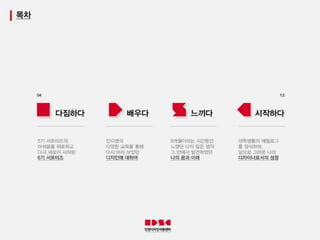













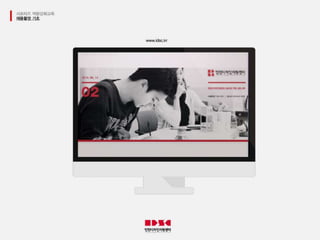
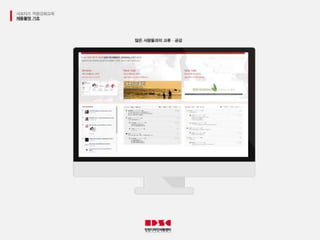


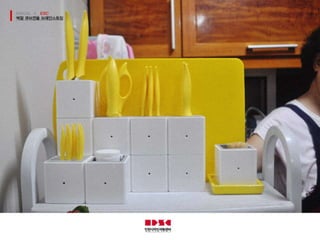



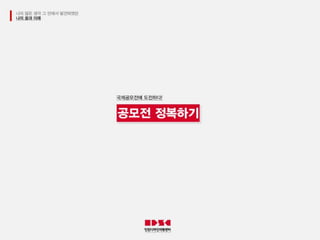

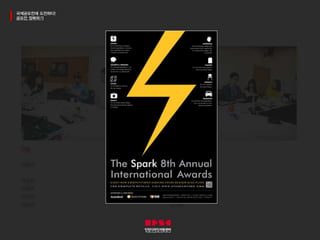
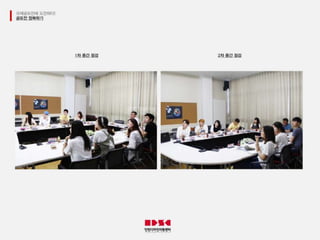





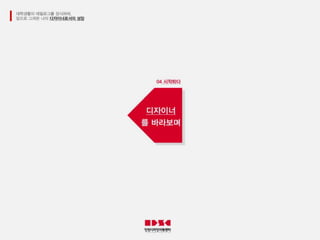





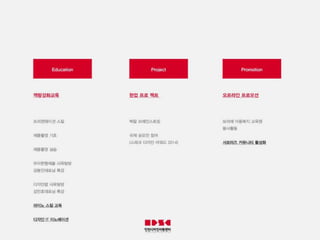








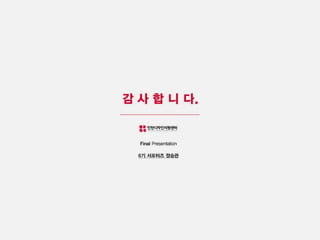
Ad
Recommended
MS/MS, Tandem Mass Spectrometry
MS/MS, Tandem Mass SpectrometryVrushali Tambe
Мэ
Tandem mass spectrometry is a technique that uses two or more mass spectrometers coupled together to analyze chemical samples. There are two types - tandem in time and tandem in space. Tandem in time uses one instrument to select an ion for fragmentation and then analyze the daughter ions. Tandem in space uses separate instruments where the first selects an ion for fragmentation in the interaction cell, and the second analyzes the product ions. Common fragmentation techniques include collision induced dissociation, electron capture dissociation, and photodissociation. Tandem MS can be used to obtain product ion spectra to identify compounds or perform selected reaction monitoring for quantitative analysis.FTIT Spectroscopy- Dr. A. Amsavel
FTIT Spectroscopy- Dr. A. AmsavelDr. Amsavel A
Мэ
The document provides a comprehensive overview of Fourier Transform Infrared (FTIR) Spectroscopy, covering its principles, instrumentation, history, operational methods, and applications in the pharmaceutical industry. It details the mechanisms of IR absorption, types of vibrations and instrumentation components such as sources and detectors, alongside sampling techniques for various states of matter. Additionally, it touches on qualification procedures to ensure the reliability of FTIR instruments in compliance with industry standards.Paper electrophoresis
Paper electrophoresisSireesha1996
Мэ
Paper electrophoresis is a technique used to separate molecules like proteins and amino acids based on their charge. It works by applying a low voltage across a strip of paper soaked in a buffer solution, causing charged molecules to migrate across the paper at different rates depending on their charge. Paper electrophoresis has applications in diagnostic testing by analyzing serum proteins, and can also be used to analyze proteins in muscle, eggs, milk, and snake and insect venoms.Atmospheric Pressure Chemical Ionization
Atmospheric Pressure Chemical IonizationVISHAL THAKUR
Мэ
Atmospheric Pressure Chemical Ionization (APCI) is an ionization method that uses ion-molecule reactions to ionize samples, facilitated by a nebulization process and corona discharge. This method is beneficial for less-polar compounds and provides an excellent interface for liquid chromatography-mass spectrometry (LC/MS). However, APCI is sensitive to contaminants and has relatively low ion currents and complex hardware requirements.Mass spectrometer
Mass spectrometervenuakkanapally
Мэ
Mass spectrometry is an analytical technique that ionizes chemical species and sorts the ions based on their mass-to-charge ratio. It can provide qualitative and quantitative data about samples on an atomic or molecular level. The document discusses the principle, instrumentation, and applications of mass spectrometry. Key components of mass spectrometers include an ion source, accelerating system, magnetic field, ion separator, ion collector, and vacuum system. Mass spectrometry has applications in structure elucidation, detection of impurities, quantitative analysis, and various clinical and forensic analyses.BITS - Introduction to Mass Spec data generation
BITS - Introduction to Mass Spec data generationBITS
Мэ
Mass spectrometry is a technique that analyzes molecules based on their mass-to-charge ratio. It involves ionizing samples using sources like MALDI or ESI, separating the ions using mass analyzers like time-of-flight or quadrupole, and detecting the ions. Tandem mass spectrometry allows targeted fragmentation of selected ions to gain additional structural information. Amino acids are the building blocks of proteins and contain variable side chains attached to a common peptide backbone. Mass spectrometry is useful for analyzing proteins and peptides.Ionisation tech
Ionisation techceutics1315
Мэ
The document discusses various ionization techniques used in mass spectrometry. There are two main categories - gas phase ionization and desorption ionization. Electron impact ionization is the most widely used gas phase technique, producing molecular ions and extensive fragmentation. Chemical ionization uses reagent gas to ionize samples more gently via proton or charge transfer. Desorption techniques like MALDI, ESI and FAB ionize high molecular weight biomolecules by incorporating the sample into a matrix and using laser or atom bombardment to induce ionization.HPTLC
HPTLCshaisejacob
Мэ
HPTLC is a sophisticated form of thin layer chromatography that allows for efficient separation and analysis of samples in a short period of time. The key steps in HPTLC include sample preparation, selecting a chromatographic layer, applying the sample, developing the plate in a mobile phase, detecting spots on the plate, and scanning/documenting results. HPTLC offers advantages over other chromatography methods like simultaneous processing of samples and standards, lower analysis times, and less cost per analysis. It has applications in fields like pharmaceutical analysis, biochemistry, and pharmacokinetic studies.Validation of IR instrument
Validation of IR instrumentSanthosh Kalakar dj
Мэ
This document discusses the qualification of Fourier transform infrared spectroscopy (FTIR). It begins with an introduction to FTIR, describing how it works and its advantages over dispersive spectroscopy. It then discusses instrumentation components like radiation sources, interferometers, and detectors. The document outlines various inspection methods used to qualify FTIR like wave number precision, 0% transmittance, linearity, and repeatability. It provides details on performing and validating the qualification using a validation program and stored reference data. Finally, it lists some applications of FTIR in pharmaceutical analysis like identification, structure determination, and reaction studies.Nmr spectroscopy:- An overview and its principle
Nmr spectroscopy:- An overview and its principleSMGJAFAR
Мэ
NMR spectroscopy is a technique that uses radio waves to analyze atomic nuclei and determine molecular structures. It is based on detecting radio signal absorption by atomic nuclei within a magnetic field. 1H and 13C NMR are common types. The history and principles of NMR are described, including how nuclei with spin absorb electromagnetic radiation and how chemical shifts, splitting, and intensity of signals provide structural information. Applications include identifying molecular structures, purity, and composition in fields like forensics, medicine, and materials analysis. Forensic uses include analyzing trace evidence, controlled substances, and toxins.LC-MS
LC-MSlakshmi narayana
Мэ
The document provides an overview of liquid chromatography-mass spectrometry (LC-MS). It discusses how LC-MS couples liquid chromatography separation with mass spectrometry detection. Key components discussed include the high performance liquid chromatography system, various ionization sources like electrospray ionization and atmospheric pressure chemical ionization, and mass analyzers like quadrupoles, time-of-flight, ion traps, and Fourier transform-ion cyclotron resonance. Sample preparation methods and applications of LC-MS are also summarized.Gas chromatography sag2020
Gas chromatography sag2020SuchetaGaikwad3
Мэ
The document provides an overview of chromatography, particularly gas chromatography, detailing its principles, components, detectors, and applications. It highlights the importance of the stationary and mobile phases in the separation process and discusses various types of columns used in the technique. Additionally, the document outlines the advantages and disadvantages of different detectors and the operational details necessary for effective gas chromatography.Chapter 5 (GC)
Chapter 5 (GC)Sunita Jobli
Мэ
This document discusses gas chromatography apparatus and applications. It describes the key components of a GC system including the carrier gas supply, sample injection system, column, column thermostating, and detectors such as thermal conductivity and flame ionization. It also discusses stationary phases, qualitative and quantitative analysis applications, calibration with standards, and internal standard methods. Quantitative GC analysis is based on comparing analyte peak heights or areas to calibration standards to obtain concentration.Uv vis-ir spectroscopy
Uv vis-ir spectroscopySadiq Rahim
Мэ
The document describes the components and working of infrared (IR) spectrometers and Fourier transform infrared (FTIR) spectrometers. It discusses various IR sources like the Nernst glower, Globar, and tungsten filament lamp. It also describes optical components like entrance and exit slits, and detectors like thermal detectors and quantum detectors. The key advantages of FTIR spectrometers are provided, including higher resolution and throughput compared to dispersive instruments. Applications of IR and Raman spectroscopy in areas like drug analysis, fiber analysis, and biological analysis are also mentioned. FTIR(Fourier transform infrared) spectroscopy
FTIR(Fourier transform infrared) spectroscopy Preeti Choudhary
Мэ
The document provides an overview of Fourier Transform Infrared (FT-IR) spectroscopy, explaining its principles, advantages, and the differences from dispersive infrared spectrometers. FT-IR utilizes an interferometer for rapid and sensitive measurements, allowing simultaneous collection of all infrared frequencies, which enhances efficiency and accuracy in identifying materials. Sampling techniques for various states of matter (liquid, solid, and gas) are also discussed, along with the instrumental process involved in obtaining infrared spectra.karl fischer titration slide
karl fischer titration slideFaruk Hossen
Мэ
This document discusses Karl Fischer titration, which is a method for determining the water content in a sample. It involves titrating the sample with a Karl Fischer reagent, which contains iodine, sulfur dioxide, and an alcohol solvent. There are two main types of Karl Fischer titration: coulometric titration, where iodine is generated in the titration cell, and volumetric titration, where a solution with a known iodine concentration is used as the titrant. The endpoint is detected electrochemically. Karl Fischer titration is used in various industries to measure water content in products like oils, plastics, gases, cosmetics, pharmaceuticals, and food. A limitation is that theIonization Techniques in LC-MS
Ionization Techniques in LC-MSRaghavendra institute of pharmaceutical education and research .
Мэ
This document presents a seminar on ionization techniques in LC-MS (Liquid Chromatography-Mass Spectrometry) as part of the curricular requirements for a Master of Pharmacy program. It covers the integration of HPLC with mass spectrometry, various ionization methods such as Electron Ionization, Chemical Ionization, and Atmospheric Pressure Ionization, discussing their principles and applications. The material is intended to enhance understanding of analytical techniques and their relevance in pharmaceutical analysis.Applications of thin layer chromatography ppt by ann
Applications of thin layer chromatography ppt by annAnjali Rarichan
Мэ
This document discusses various applications of thin layer chromatography (TLC). It describes how TLC can be used as a check on purification processes in organic chemistry and for separating inorganic ions, amino acids, vitamins, and components of food. TLC allows for isolation and identification of individual components in mixtures. It also has quantitative applications through analyzing fractions on a plate or determining fractions after elution. Different modes of TLC separation are also mentioned such as adsorption, ion exchange, partition, and reversed phase partition TLC.Ion exchange chromatography -әЭәЭЯЈShare
Ion exchange chromatography -әЭәЭЯЈShareRIZWAN RIZWI
Мэ
Ion exchange chromatography separates ions and polar molecules based on their affinity to an ion exchanger, applicable to various charged molecules including proteins and nucleotides. The method utilizes resins classified into strong and weak cation and anion types, with regeneration through acid or base treatment. Key factors affecting the process include resin properties, ion characteristics, and mobile phase conditions, making it useful for applications like water treatment and biochemical analysis.Hplc
Hplc Yunesalsayadi
Мэ
This document discusses various concepts related to high performance liquid chromatography (HPLC) peak analysis including:
1. It describes factors that influence peak shape such as column packing, mobile phase composition, pH, and buffers which can improve peak symmetry and resolution.
2. Key parameters for characterizing chromatographic performance are discussed including retention factor (k), selectivity factor (Оұ), plate number (N), and height equivalent of a theoretical plate (HETP).
3. Optimizing these parameters through adjusting mobile phase or column properties can enhance separation and analysis of chromatographic runs.Anil bl gather mass spectrometry
Anil bl gather mass spectrometryANIL BL GATHER
Мэ
Mass spectrometry is a powerful technique for protein identification and quantification. It involves several key steps: protein extraction and digestion, peptide separation by liquid chromatography, ionization of peptides using techniques like MALDI or ESI, mass analysis using instruments like quadrupoles or orbitraps to separate ions by mass-to-charge ratio, and data analysis to identify proteins from the mass spectra. Tandem mass spectrometry uses collision-induced dissociation to fragment peptides and generate sequence information that allows unambiguous protein identification.Tandem Mass spectrometry
Tandem Mass spectrometryAsif Javed
Мэ
This document discusses tandem mass spectrometry techniques. It describes two types of tandem MS: tandem-in-space, where separation elements are physically separated and tandem-in-time where separation is accomplished over time within a single instrument. It also outlines four main scan experiments - precursor ion scan, product ion scan, selected reaction monitoring, and neutral loss scan. Fragmentation techniques discussed include in-source fragmentation, post-source fragmentation using collision-induced dissociation, and notation for indicating peptide fragments.Chromatography(gc ms & lc ms)
Chromatography(gc ms & lc ms)Vidya Kalaivani Rajkumar
Мэ
- Gas chromatography-mass spectrometry (GC-MS) is an analytical method that combines the features of gas-liquid chromatography and mass spectrometry to identify different substances within a test sample.
- GC is used to separate and analyze compounds that can be vaporized without decomposition, while MS is used to measure the mass-to-charge ratios of ions to determine the molecular mass and structure of molecules eluting from the GC.
- The combination of GC and MS provides a powerful tool for analyzing complex mixtures by separating compounds and identifying their chemical structures.Matrix Effect
Matrix EffectDr. Amit Patel
Мэ
The document discusses matrix effects, which occur when components in biological samples interfere with the ionization process during mass spectrometry analysis, potentially enhancing or suppressing the signal of the analyte. Matrix effects can negatively impact accuracy, precision, and detection limits. Two types of matrix effects are described - qualitative effects seen through post-column infusion experiments and quantitative effects evaluated by measuring the matrix factor. Approaches to minimize matrix effects include optimizing extraction and chromatography procedures, using stable isotope internal standards, and selecting an APCI ionization source instead of ESI when possible.Difference between HPLC and UPLC
Difference between HPLC and UPLCVrushali Tambe
Мэ
UPLC uses smaller particle sizes (<2 microns) than HPLC (3-5 microns) which allows it to operate at higher pressures and provide faster, more sensitive and selective separations compared to HPLC. Some key differences are that UPLC uses smaller diameter columns, achieves higher resolution and plate counts, reduces run times, solvent consumption and cost of operation compared to HPLC. However, the smaller particles used in UPLC columns have a narrower usable lifespan than HPLC columns.Ion Cyclotron Resonance - Mass Spectrometery by Ghulam Mustafa Channa
Ion Cyclotron Resonance - Mass Spectrometery by Ghulam Mustafa Channa Ghulam Mustafa
Мэ
This document provides an overview of ion cyclotron resonance (ICR) mass spectrometry. It discusses the basic components of a mass spectrometer, including the ionization source, mass analyzer, and ion detector. The document focuses on ICR, explaining its history, working principle, instrumentation, applications, advantages over other mass analyzers, and limitations. Key points covered include how ICR uses a magnetic field to accelerate ions in a spiral path between "Dees" to separate ions based on their mass-to-charge ratio. ICR provides extremely high mass resolution and accuracy for analyzing samples.Uv visible sprctroscopy ppt
Uv visible sprctroscopy pptnehla313
Мэ
The document provides an introduction to spectroscopy, focusing on the measurement and interpretation of electromagnetic radiation absorbed or emitted by atoms or molecules. It discusses the types of electromagnetic radiation, their energy relationships, and various electronic transitions involved in UV and visible spectroscopy. Additionally, it covers important concepts such as chromophores, solvent effects, and the laws governing absorption of radiation, including Beer's and Lambert's laws.Sample preparation techniques for biological sample
Sample preparation techniques for biological sampleCSIR-Central Drug Research Institute
Мэ
The document discusses various sample preparation techniques for biological fluids in analytical chemistry, emphasizing the need for such processes due to the complex nature of biological matrices that can contaminate instruments. Techniques covered include protein precipitation, liquid-liquid extraction, solid-phase extraction, and alternatives like dialysis and affinity sorbent extraction, each with distinct advantages and disadvantages. It highlights modern laboratory practices, particularly the utilization of 96-well plates for high-throughput sample processing.Itм„ңнҸ¬н„°мҰҲ мҶҢк°ңмһҗлЈҢ
Itм„ңнҸ¬н„°мҰҲ мҶҢк°ңмһҗлЈҢco-pen co-work company
Мэ
2007л…„л¶Җн„° мӢңмһ‘лҗң KT ITм„ңнҸ¬н„°мҰҲлҠ” кё°м—… мӮ¬нҡҢкіөн—ҢнҷңлҸҷмқҳ нҢЁлҹ¬лӢӨмһ„мқ„ л°”кҫј кё°м—…мқҳ лҢҖн‘ңм Ғмқё мһ¬лҠҘкё°л¶Җнҳ• н”„лЎңліҙл…ё мӮ¬нҡҢкіөн—ҢнҷңлҸҷмңјлЎңм„ң, IT м§ҖмӢқ кё°л¶ҖлҘј нҶөн•ҙ лҲ„кө¬лӮҳ ITлҘј мһҗмң лЎӯкІҢ нҷңмҡ©н• мҲҳ мһҲлҸ„лЎқ лҸ•лҠ” ktмқҳ м§Ғмӣҗ лҙүмӮ¬лӢЁмһ…лӢҲлӢӨ. [мһҗлӘҪ] лҢҖн•ҷмғқ кё°м—… м—°кі„ лҢҖмҷёнҷңлҸҷ н”„лЎңк·ёлһЁ м„ң비мҠӨ мҶҢк°ңм„ң
[мһҗлӘҪ] лҢҖн•ҷмғқ кё°м—… м—°кі„ лҢҖмҷёнҷңлҸҷ н”„лЎңк·ёлһЁ м„ң비мҠӨ мҶҢк°ңм„ң Kunwon Kim
Мэ
лҢҖн•ҷмғқ кіөк°җл„ӨнҠёмӣҢнҒ¬ 'мһҗлӘҪ' мқҳ лҢҖн•ҷмғқ лҢҖмҷёнҷңлҸҷ кіөмӢқ м„ң비мҠӨ лёҢлһңл“ң мһ…лӢҲлӢӨ. м„ңнҸ¬н„°мҰҲ, л§ҲмјҖн„°, лҰ¬нҸ¬н„°, кё°мһҗлӢЁ л“ұ лӢӨм–‘н•ң м№ҙн…Ңкі лҰ¬мқҳ нҷңлҸҷмқ„ м§Җмӣҗн•ҙл“ңлҰ¬л©°, нҷңм„ұнҷ” л°Ҹ кё°м—…мқҳ лӘ©м Ғкіј н•ҷмғқмқҳ м„ Ліём—җ л§һм¶° н”„лЎңк·ёлһЁмқ„ кө¬м„ұн•ҙл“ңлҰҪлӢҲлӢӨ.
лҢҖн•ҷмғқ м „л¬ёмұ„л„җ 'лҜёл””м–ҙмһҗлӘҪ' лӮҙ мҪҳн…җмё кІҢмһ¬ л°Ҹ лӘЁк°қл¶Җн„° мҪҳн…җмё л…ём¶ңк№Ңм§Җ л°”мқҙлҹҙмқ„ нҶөн•ң нҷңм„ұнҷ” н”„лЎңк·ёлһЁмқ„ мҡҙмҳҒмӨ‘м—җ мһҲмҠөлӢҲлӢӨ.
л¬ёмқҳмӮ¬н•ӯ: wenis@artpr.kr
л¬ёмқҳм „нҷ”: 070-7766-8812
More Related Content
What's hot (20)
Validation of IR instrument
Validation of IR instrumentSanthosh Kalakar dj
Мэ
This document discusses the qualification of Fourier transform infrared spectroscopy (FTIR). It begins with an introduction to FTIR, describing how it works and its advantages over dispersive spectroscopy. It then discusses instrumentation components like radiation sources, interferometers, and detectors. The document outlines various inspection methods used to qualify FTIR like wave number precision, 0% transmittance, linearity, and repeatability. It provides details on performing and validating the qualification using a validation program and stored reference data. Finally, it lists some applications of FTIR in pharmaceutical analysis like identification, structure determination, and reaction studies.Nmr spectroscopy:- An overview and its principle
Nmr spectroscopy:- An overview and its principleSMGJAFAR
Мэ
NMR spectroscopy is a technique that uses radio waves to analyze atomic nuclei and determine molecular structures. It is based on detecting radio signal absorption by atomic nuclei within a magnetic field. 1H and 13C NMR are common types. The history and principles of NMR are described, including how nuclei with spin absorb electromagnetic radiation and how chemical shifts, splitting, and intensity of signals provide structural information. Applications include identifying molecular structures, purity, and composition in fields like forensics, medicine, and materials analysis. Forensic uses include analyzing trace evidence, controlled substances, and toxins.LC-MS
LC-MSlakshmi narayana
Мэ
The document provides an overview of liquid chromatography-mass spectrometry (LC-MS). It discusses how LC-MS couples liquid chromatography separation with mass spectrometry detection. Key components discussed include the high performance liquid chromatography system, various ionization sources like electrospray ionization and atmospheric pressure chemical ionization, and mass analyzers like quadrupoles, time-of-flight, ion traps, and Fourier transform-ion cyclotron resonance. Sample preparation methods and applications of LC-MS are also summarized.Gas chromatography sag2020
Gas chromatography sag2020SuchetaGaikwad3
Мэ
The document provides an overview of chromatography, particularly gas chromatography, detailing its principles, components, detectors, and applications. It highlights the importance of the stationary and mobile phases in the separation process and discusses various types of columns used in the technique. Additionally, the document outlines the advantages and disadvantages of different detectors and the operational details necessary for effective gas chromatography.Chapter 5 (GC)
Chapter 5 (GC)Sunita Jobli
Мэ
This document discusses gas chromatography apparatus and applications. It describes the key components of a GC system including the carrier gas supply, sample injection system, column, column thermostating, and detectors such as thermal conductivity and flame ionization. It also discusses stationary phases, qualitative and quantitative analysis applications, calibration with standards, and internal standard methods. Quantitative GC analysis is based on comparing analyte peak heights or areas to calibration standards to obtain concentration.Uv vis-ir spectroscopy
Uv vis-ir spectroscopySadiq Rahim
Мэ
The document describes the components and working of infrared (IR) spectrometers and Fourier transform infrared (FTIR) spectrometers. It discusses various IR sources like the Nernst glower, Globar, and tungsten filament lamp. It also describes optical components like entrance and exit slits, and detectors like thermal detectors and quantum detectors. The key advantages of FTIR spectrometers are provided, including higher resolution and throughput compared to dispersive instruments. Applications of IR and Raman spectroscopy in areas like drug analysis, fiber analysis, and biological analysis are also mentioned. FTIR(Fourier transform infrared) spectroscopy
FTIR(Fourier transform infrared) spectroscopy Preeti Choudhary
Мэ
The document provides an overview of Fourier Transform Infrared (FT-IR) spectroscopy, explaining its principles, advantages, and the differences from dispersive infrared spectrometers. FT-IR utilizes an interferometer for rapid and sensitive measurements, allowing simultaneous collection of all infrared frequencies, which enhances efficiency and accuracy in identifying materials. Sampling techniques for various states of matter (liquid, solid, and gas) are also discussed, along with the instrumental process involved in obtaining infrared spectra.karl fischer titration slide
karl fischer titration slideFaruk Hossen
Мэ
This document discusses Karl Fischer titration, which is a method for determining the water content in a sample. It involves titrating the sample with a Karl Fischer reagent, which contains iodine, sulfur dioxide, and an alcohol solvent. There are two main types of Karl Fischer titration: coulometric titration, where iodine is generated in the titration cell, and volumetric titration, where a solution with a known iodine concentration is used as the titrant. The endpoint is detected electrochemically. Karl Fischer titration is used in various industries to measure water content in products like oils, plastics, gases, cosmetics, pharmaceuticals, and food. A limitation is that theIonization Techniques in LC-MS
Ionization Techniques in LC-MSRaghavendra institute of pharmaceutical education and research .
Мэ
This document presents a seminar on ionization techniques in LC-MS (Liquid Chromatography-Mass Spectrometry) as part of the curricular requirements for a Master of Pharmacy program. It covers the integration of HPLC with mass spectrometry, various ionization methods such as Electron Ionization, Chemical Ionization, and Atmospheric Pressure Ionization, discussing their principles and applications. The material is intended to enhance understanding of analytical techniques and their relevance in pharmaceutical analysis.Applications of thin layer chromatography ppt by ann
Applications of thin layer chromatography ppt by annAnjali Rarichan
Мэ
This document discusses various applications of thin layer chromatography (TLC). It describes how TLC can be used as a check on purification processes in organic chemistry and for separating inorganic ions, amino acids, vitamins, and components of food. TLC allows for isolation and identification of individual components in mixtures. It also has quantitative applications through analyzing fractions on a plate or determining fractions after elution. Different modes of TLC separation are also mentioned such as adsorption, ion exchange, partition, and reversed phase partition TLC.Ion exchange chromatography -әЭәЭЯЈShare
Ion exchange chromatography -әЭәЭЯЈShareRIZWAN RIZWI
Мэ
Ion exchange chromatography separates ions and polar molecules based on their affinity to an ion exchanger, applicable to various charged molecules including proteins and nucleotides. The method utilizes resins classified into strong and weak cation and anion types, with regeneration through acid or base treatment. Key factors affecting the process include resin properties, ion characteristics, and mobile phase conditions, making it useful for applications like water treatment and biochemical analysis.Hplc
Hplc Yunesalsayadi
Мэ
This document discusses various concepts related to high performance liquid chromatography (HPLC) peak analysis including:
1. It describes factors that influence peak shape such as column packing, mobile phase composition, pH, and buffers which can improve peak symmetry and resolution.
2. Key parameters for characterizing chromatographic performance are discussed including retention factor (k), selectivity factor (Оұ), plate number (N), and height equivalent of a theoretical plate (HETP).
3. Optimizing these parameters through adjusting mobile phase or column properties can enhance separation and analysis of chromatographic runs.Anil bl gather mass spectrometry
Anil bl gather mass spectrometryANIL BL GATHER
Мэ
Mass spectrometry is a powerful technique for protein identification and quantification. It involves several key steps: protein extraction and digestion, peptide separation by liquid chromatography, ionization of peptides using techniques like MALDI or ESI, mass analysis using instruments like quadrupoles or orbitraps to separate ions by mass-to-charge ratio, and data analysis to identify proteins from the mass spectra. Tandem mass spectrometry uses collision-induced dissociation to fragment peptides and generate sequence information that allows unambiguous protein identification.Tandem Mass spectrometry
Tandem Mass spectrometryAsif Javed
Мэ
This document discusses tandem mass spectrometry techniques. It describes two types of tandem MS: tandem-in-space, where separation elements are physically separated and tandem-in-time where separation is accomplished over time within a single instrument. It also outlines four main scan experiments - precursor ion scan, product ion scan, selected reaction monitoring, and neutral loss scan. Fragmentation techniques discussed include in-source fragmentation, post-source fragmentation using collision-induced dissociation, and notation for indicating peptide fragments.Chromatography(gc ms & lc ms)
Chromatography(gc ms & lc ms)Vidya Kalaivani Rajkumar
Мэ
- Gas chromatography-mass spectrometry (GC-MS) is an analytical method that combines the features of gas-liquid chromatography and mass spectrometry to identify different substances within a test sample.
- GC is used to separate and analyze compounds that can be vaporized without decomposition, while MS is used to measure the mass-to-charge ratios of ions to determine the molecular mass and structure of molecules eluting from the GC.
- The combination of GC and MS provides a powerful tool for analyzing complex mixtures by separating compounds and identifying their chemical structures.Matrix Effect
Matrix EffectDr. Amit Patel
Мэ
The document discusses matrix effects, which occur when components in biological samples interfere with the ionization process during mass spectrometry analysis, potentially enhancing or suppressing the signal of the analyte. Matrix effects can negatively impact accuracy, precision, and detection limits. Two types of matrix effects are described - qualitative effects seen through post-column infusion experiments and quantitative effects evaluated by measuring the matrix factor. Approaches to minimize matrix effects include optimizing extraction and chromatography procedures, using stable isotope internal standards, and selecting an APCI ionization source instead of ESI when possible.Difference between HPLC and UPLC
Difference between HPLC and UPLCVrushali Tambe
Мэ
UPLC uses smaller particle sizes (<2 microns) than HPLC (3-5 microns) which allows it to operate at higher pressures and provide faster, more sensitive and selective separations compared to HPLC. Some key differences are that UPLC uses smaller diameter columns, achieves higher resolution and plate counts, reduces run times, solvent consumption and cost of operation compared to HPLC. However, the smaller particles used in UPLC columns have a narrower usable lifespan than HPLC columns.Ion Cyclotron Resonance - Mass Spectrometery by Ghulam Mustafa Channa
Ion Cyclotron Resonance - Mass Spectrometery by Ghulam Mustafa Channa Ghulam Mustafa
Мэ
This document provides an overview of ion cyclotron resonance (ICR) mass spectrometry. It discusses the basic components of a mass spectrometer, including the ionization source, mass analyzer, and ion detector. The document focuses on ICR, explaining its history, working principle, instrumentation, applications, advantages over other mass analyzers, and limitations. Key points covered include how ICR uses a magnetic field to accelerate ions in a spiral path between "Dees" to separate ions based on their mass-to-charge ratio. ICR provides extremely high mass resolution and accuracy for analyzing samples.Uv visible sprctroscopy ppt
Uv visible sprctroscopy pptnehla313
Мэ
The document provides an introduction to spectroscopy, focusing on the measurement and interpretation of electromagnetic radiation absorbed or emitted by atoms or molecules. It discusses the types of electromagnetic radiation, their energy relationships, and various electronic transitions involved in UV and visible spectroscopy. Additionally, it covers important concepts such as chromophores, solvent effects, and the laws governing absorption of radiation, including Beer's and Lambert's laws.Sample preparation techniques for biological sample
Sample preparation techniques for biological sampleCSIR-Central Drug Research Institute
Мэ
The document discusses various sample preparation techniques for biological fluids in analytical chemistry, emphasizing the need for such processes due to the complex nature of biological matrices that can contaminate instruments. Techniques covered include protein precipitation, liquid-liquid extraction, solid-phase extraction, and alternatives like dialysis and affinity sorbent extraction, each with distinct advantages and disadvantages. It highlights modern laboratory practices, particularly the utilization of 96-well plates for high-throughput sample processing.Viewers also liked (18)
Itм„ңнҸ¬н„°мҰҲ мҶҢк°ңмһҗлЈҢ
Itм„ңнҸ¬н„°мҰҲ мҶҢк°ңмһҗлЈҢco-pen co-work company
Мэ
2007л…„л¶Җн„° мӢңмһ‘лҗң KT ITм„ңнҸ¬н„°мҰҲлҠ” кё°м—… мӮ¬нҡҢкіөн—ҢнҷңлҸҷмқҳ нҢЁлҹ¬лӢӨмһ„мқ„ л°”кҫј кё°м—…мқҳ лҢҖн‘ңм Ғмқё мһ¬лҠҘкё°л¶Җнҳ• н”„лЎңліҙл…ё мӮ¬нҡҢкіөн—ҢнҷңлҸҷмңјлЎңм„ң, IT м§ҖмӢқ кё°л¶ҖлҘј нҶөн•ҙ лҲ„кө¬лӮҳ ITлҘј мһҗмң лЎӯкІҢ нҷңмҡ©н• мҲҳ мһҲлҸ„лЎқ лҸ•лҠ” ktмқҳ м§Ғмӣҗ лҙүмӮ¬лӢЁмһ…лӢҲлӢӨ. [мһҗлӘҪ] лҢҖн•ҷмғқ кё°м—… м—°кі„ лҢҖмҷёнҷңлҸҷ н”„лЎңк·ёлһЁ м„ң비мҠӨ мҶҢк°ңм„ң
[мһҗлӘҪ] лҢҖн•ҷмғқ кё°м—… м—°кі„ лҢҖмҷёнҷңлҸҷ н”„лЎңк·ёлһЁ м„ң비мҠӨ мҶҢк°ңм„ң Kunwon Kim
Мэ
лҢҖн•ҷмғқ кіөк°җл„ӨнҠёмӣҢнҒ¬ 'мһҗлӘҪ' мқҳ лҢҖн•ҷмғқ лҢҖмҷёнҷңлҸҷ кіөмӢқ м„ң비мҠӨ лёҢлһңл“ң мһ…лӢҲлӢӨ. м„ңнҸ¬н„°мҰҲ, л§ҲмјҖн„°, лҰ¬нҸ¬н„°, кё°мһҗлӢЁ л“ұ лӢӨм–‘н•ң м№ҙн…Ңкі лҰ¬мқҳ нҷңлҸҷмқ„ м§Җмӣҗн•ҙл“ңлҰ¬л©°, нҷңм„ұнҷ” л°Ҹ кё°м—…мқҳ лӘ©м Ғкіј н•ҷмғқмқҳ м„ Ліём—җ л§һм¶° н”„лЎңк·ёлһЁмқ„ кө¬м„ұн•ҙл“ңлҰҪлӢҲлӢӨ.
лҢҖн•ҷмғқ м „л¬ёмұ„л„җ 'лҜёл””м–ҙмһҗлӘҪ' лӮҙ мҪҳн…җмё кІҢмһ¬ л°Ҹ лӘЁк°қл¶Җн„° мҪҳн…җмё л…ём¶ңк№Ңм§Җ л°”мқҙлҹҙмқ„ нҶөн•ң нҷңм„ұнҷ” н”„лЎңк·ёлһЁмқ„ мҡҙмҳҒмӨ‘м—җ мһҲмҠөлӢҲлӢӨ.
л¬ёмқҳмӮ¬н•ӯ: wenis@artpr.kr
л¬ёмқҳм „нҷ”: 070-7766-8812
мӢұкёҖмЎұл“Өмқҳ мқҳмӢқмЈј м—°кө¬ мЎ°мӮ¬
мӢұкёҖмЎұл“Өмқҳ мқҳмӢқмЈј м—°кө¬ мЎ°мӮ¬SeungKwan Jeong
Мэ
мӢұкёҖмҠҲлЁёл“Өмқҳ мқҳ,мӢқ,мЈј лҘј мЎ°мӮ¬н•ҙліҙкі
мӢұкёҖмҠҲлЁёл“Өмқҙ лҚ” нҺёлҰ¬н• мҲҳ мһҲлҠ” лқјмқҙн”„ мҠӨнғҖмқјмқ„ м ңм•Ҳн•ҙліёлӢӨм„ңмҡёнҳҒмӢ м„јн„° лҰ¬л№ҷлһ© '1мқё к°Җкө¬ мЈјкұ°л№ҲкіӨ' н•ҙкІ° мҳӨн”Ҳн…Ңмқҙлё” л°ңн‘ңмһҗлЈҢ
м„ңмҡёнҳҒмӢ м„јн„° лҰ¬л№ҷлһ© '1мқё к°Җкө¬ мЈјкұ°л№ҲкіӨ' н•ҙкІ° мҳӨн”Ҳн…Ңмқҙлё” л°ңн‘ңмһҗлЈҢChanyoung Youn
Мэ
м„ңмҡёнҳҒмӢ м„јн„° лҰ¬л№ҷлһ©мқҙ '1мқё к°Җкө¬ мЈјкұ°л№ҲкіӨ' н•ҙкІ°мқ„ мң„н•ҙ 진н–үн•ң мҳӨн”Ҳн…Ңмқҙлё” л°ңн‘ңмһҗлЈҢGov 3.0 кё°л°ҳмқҳ м •л¶Җм„ң비мҠӨ нҢЁлҹ¬лӢӨмһ„ ліҖнҷ” л°Ҹ м „лһө
Gov 3.0 кё°л°ҳмқҳ м •л¶Җм„ң비мҠӨ нҢЁлҹ¬лӢӨмһ„ ліҖнҷ” л°Ҹ м „лһөTaewon Kim
Мэ
кё°мҲ мқ„ кі лҜјн•ҳм§Җ л§Ҳм„ёмҡ”. мӮ¬лһҢмқ„ кі лҜјн•ҳм„ёмҡ” :)мӮ°м—…мһ¬н•ҙ(2015 03 27)мөңмў…
мӮ°м—…мһ¬н•ҙ(2015 03 27)мөңмў…лҚ”л¶Ҳм–ҙ мӮ¶
Мэ
н•ңкөӯкІҪм ңмҷҖ мӮ°м—…мһ¬н•ҙ - 2015л…„ 3мӣ” 28мқј лҚ”л¶Ҳм–ҙмӮ¶ лҜјмғқнҶ нҒ¬ л°ңн‘ңмһҗлЈҢ / Economy of Korea and Industrial Disaster[нҸ¬нҠёнҸҙлҰ¬мҳӨ] мҳЁлқјмқёлёҢлһңл“ңл””л үн„° к°•м •мқҖ
[нҸ¬нҠёнҸҙлҰ¬мҳӨ] мҳЁлқјмқёлёҢлһңл“ңл””л үн„° к°•м •мқҖJUNGEUN KANG
Мэ
кІҪн—ҳмқ„ кё°лЎқн•ҳм—¬ кІҪл ҘмңјлЎң
http://onbranding.kr/мӢұкёҖлқјмқҙн”„ м—°кө¬
мӢұкёҖлқјмқҙн”„ м—°кө¬SeungKwan Jeong
Мэ
нҳ‘м„ұлҢҖн•ҷкөҗ м ңн’Ҳл””мһҗмқён•ҷкіј 18нҡҢ мЎём—…м „мӢңнҡҢ
мӣҗн•ҳлӢӨ (мӢұкёҖмЎұл“Өмқҙ мӣҗн•ҳлҠ” м ңн’Ҳкіј лқјмқҙн”„мҠӨнғҖмқј м ңм•Ҳ)
1мқёк°Җкө¬ мӢұкёҖмЎұл“Өмқҳ мӢұкёҖлқјмқҙн”„м—җ лҢҖн•ң лӘЁл“ кІғ2012 нҳҲм•ЎкІҖ진н‘ң м„ң비мҠӨл””мһҗмқё мӮ¬мқҙн”ҪмҠӨ н•ңкөӯл””мһҗмқём§„нқҘмӣҗ
2012 нҳҲм•ЎкІҖ진н‘ң м„ң비мҠӨл””мһҗмқё мӮ¬мқҙн”ҪмҠӨ н•ңкөӯл””мһҗмқём§„нқҘмӣҗн•ңкөӯл””мһҗмқём§„нқҘмӣҗ кіөкіөм„ң비мҠӨл””мһҗмқёPD
Мэ
кұҙк°•кІҖ진 кІ°кіјм„ң, м„ң비мҠӨ л””мһҗмқёмқ„ л§ҢлӮҳлӢӨ.
- м„ң비мҠӨ л””мһҗмқёмқҙ л§Ңл“Өм–ҙлӮё м№ңм Ҳн•ң кұҙк°•кІҖ진 кІ°кіјм„ң
к°ңл°ңмӮ¬ : мӮ¬мқҙн”ҪмҠӨ
м°ём—¬кё°м—… : лӘ…м§Җлі‘мӣҗ
мЈјкҙҖ : м§ҖмӢқкІҪм ңл¶Җ, н•ңкөӯл””мһҗмқём§„нқҘмӣҗ
[к°ңл°ң кІҪкіј]
в—Ӣ мқҳлЈҢкё°кё°/нҷҳкІҪмқҳ мҲҳмҡ”мһҗ мӨ‘мӢ¬ нҳҒмӢ мқ„ мң„н•ң мңөн•©нҳ• мқҳлЈҢ м„ң비мҠӨ л””мһҗмқё н”Ңлһ«нҸј к°ңл°ң R&DлЎң к°ңл°ң(2011.9~2012.8. н•ңкөӯл””мһҗмқём§„нқҘмӣҗ R&Dм§Җм •кіјм ң. мӮ¬мқҙн”ҪмҠӨ, н•ңлҸҷлҢҖн•ҷкөҗмҷҖ м»ЁмҶҢмӢңм—„)
в—Ӣ кұҙк°•кІҖ진결과 нҶөліҙм„ң лҰ¬л””мһҗмқё (вҖҳ11.09 ~ вҖҳ11.12)
в—Ӣ мӢңлІ”м Ғмҡ© : лӘ…м§Җлі‘мӣҗ, мҲҳкІҖмһҗ 2,000лӘ… лҢҖмғҒ. (вҖҷ12.01 ~ вҖҷ12.02)
мЈјліҖм—җ м—°л§җмқҙ лҗҳм–ҙм„ңм•ј л°ҖлҰ° кіјм ңлҘј н•ҳл“Ҝмқҙ кёүн•ҳкІҢ кұҙк°•кІҖ진мқ„ мҳҲм•Ҫн•ҳлҠ” мӮ¬лһҢл“Өмқ„ л§Һмқҙ ліј мҲҳ мһҲлӢӨ. мҷң мҡ°лҰ¬лҠ” көӯк°Җм—җм„ң м ңкіөн•ҳлҠ” кұҙк°•кІҖ진мқ„ к·Җм°®мқҖ кіјм ңлЎңл§Ң м—¬кё°кі мһҲлҠ” кІғмқјк№Ң? м •л§җ мқҙл ҮкІҢ м—¬кІЁлҸ„ лҗҳлҠ” н•ҳм°®мқҖ кІҖ진мқјк№Ң?
мқҙлҹ¬н•ң л¬ём ңлҘј н•ҙкІ°н•ҳкё° мң„н•ҙ м§ҖмӢқкІҪм ңл¶Җ мӮ°н•ҳ н•ңкөӯл””мһҗмқём§„нқҘмӣҗмқҖ м„ң비мҠӨл””мһҗмқё м „л¬ёнҡҢмӮ¬мқё (мЈј)мӮ¬мқҙн”ҪмҠӨмҷҖ м—¬лҹ¬ 메디컬 м „л¬ёк°Җ, м»Ём„ӨнҢ… м „л¬ёк°Җл“Өкіј н•Ёк»ҳ нҢҖмқҙ лҗҳм–ҙ н”„лЎңм қнҠёлҘј 진н–үн•ҳмҳҖлӢӨ. кұҙк°•кІҖ진 м„ң비мҠӨлҠ” мқҳлЈҢ진мқҙлқјлҠ” м „л¬ёк°Җ 집лӢЁкіј м „ көӯлҜјмқҙлқјлҠ” 집лӢЁмқҙ н•Ёк»ҳ л§һл¬јл Ө мһҲлҠ”лҚ° нҳ„мһ¬лҠ” м„ң비мҠӨ м ңкіө мЈјмІҙмқё мқҳлЈҢ진м—җкІҢ кұ°мқҳ лӘЁл“ кІғмқҙ л§һ추м–ҙм ё мһҲм–ҙ, 1мӢңк°„ к°Җлҹүмқҳ кёҙ лҢҖкё°мӢңк°„ нӣ„м—җм•ј 10분лҸ„ м•Ҳ лҗҳлҠ” к°„лӢЁн•ң кІҖмӮ¬лҘј л°ӣм•„ліј мҲҳ мһҲкі , мқҙлҘј нҶөн•ҙ л‘җ лӢ¬мҜӨ л’Өм—җ л°ӣм•„ ліј мҲҳ мһҲлҠ” кІ°кіјм„ңм—җлҠ” м•Ңм•„ліҙкё° нһҳл“ мқҳн•ҷмҡ©м–ҙмҷҖ мҲҳм№ҳл“Өл§Ң л№Ҫл№ҪнһҲ м°Ё мһҲлӢӨ.
мқҙн•ҙмЎ°м°Ё н•ҳкё° м–ҙл Өмҡҙ кІ°кіјн‘ңлҘј л°ӣм•„ л“ көӯлҜјл“ӨмқҖ кІ°кіјм„ңлҘј нҷңмҡ©н•ҙм•ј н•ңлӢӨлҠ” мғқк°Ғ лҢҖмӢ к·ёлғҘ к°ҖліҚкІҢ лі„ кІғ м•„лӢҢ кІғмңјлЎң м№ҳл¶Җн•ҙлІ„лҰ¬кІҢ лҗңлӢӨ. мқҳлЈҢ진과 м „ көӯлҜј, мқҙ л‘җ 집лӢЁ к°„м—җ н’Җкё° м–ҙл Өмҡҙ м»ӨлӢӨлһҖ мҶҢнҶөмқҳ л¬ём ңк°Җ мЎҙмһ¬н•ҳкі мһҲлҠ” кІғмқҙлӢӨ. мқҳлЈҢ진과 м „ көӯлҜјмқҙ н•Ёк»ҳ мӣҗнҷңнһҲ мҶҢнҶөн• мҲҳ мһҲкІҢ н•ҳкё° мң„н•ҙ лӢӨмӢң л””мһҗмқё лҗҳм–ҙм•ј н•ҳлҠ” лҢҖмғҒмңјлЎң кІ°м •лҗҳм—ҲлҚҳ кІғмқҖ вҖҳкұҙк°•кІҖ진 кІ°кіјм„ңвҖҷмҳҖлӢӨ. мқҙ кІ°кіјм„ңлҠ” кұҙк°•кІҖ진мқҙ мҲҳкІҖмһҗмқҳ мғқнҷңм—җ м§Ғм ‘м Ғмқё мҳҒн–Ҙмқ„ лҜём№ мҲҳ мһҲлҠ” кұ°мқҳ мң мқјн•ң л§Өк°ңмІҙмқҙкё° л•Ңл¬ёмқҙлӢӨ.
...(мқҙн•ҳ мғқлһө)
* кҙҖл Ё кёҖ ліҙкё° : кұҙк°•кІҖ진 кІ°кіјм„ң, м„ң비мҠӨ л””мһҗмқёмқ„ л§ҢлӮҳлӢӨ. - мӮ¬мқҙн”ҪмҠӨ http://cafe.naver.com/usable/1650
* кҙҖл Ё кё°мӮ¬ : мӮ¶мқ„ лҚ” нҺёлҰ¬н•ҳкІҢ... 'м„ң비мҠӨ л””мһҗмқё' мӢңлҢҖлЎң - мЎ°м„ мқјліҙ, 2012.8.8.
http://news.chosun.com/site/data/html_dir/2012/08/07/2012080703384.htmlб„Ӣб…ЎбҶҜб„Ҹб…©бҶјб„ғб…ЎбҶҜб„Ҹб…©бҶј б„Ңб…®бҶјб„Җб…ЎбҶ«б„Үб…ЎбҶҜб„‘б…ӯ.Compressed
б„Ӣб…ЎбҶҜб„Ҹб…©бҶјб„ғб…ЎбҶҜб„Ҹб…©бҶј б„Ңб…®бҶјб„Җб…ЎбҶ«б„Үб…ЎбҶҜб„‘б…ӯ.Compressedмғ¬лқј л°•
Мэ
м•ҢмҪ©лӢ¬мҪ©мҳӨн”Ҳ мҶҢмҠӨ лҸ„кө¬лҘј нҷңмҡ©н•ң м„ұлҠҘ н…ҢмҠӨнҠё л°©лІ• л°Ҹ мӮ¬лЎҖ
мҳӨн”Ҳ мҶҢмҠӨ лҸ„кө¬лҘј нҷңмҡ©н•ң м„ұлҠҘ н…ҢмҠӨнҠё л°©лІ• л°Ҹ мӮ¬лЎҖMinWoo Byeon
Мэ
JMeterлҘј мқҙмҡ©н•ң м„ұлҠҘ н…ҢмҠӨнҠё мӮ¬лЎҖмһ…лӢҲлӢӨ.мҰқк°•ЛіС«ӢӨнҠёл Ңл“ң
мҰқк°•ЛіС«ӢӨнҠёл Ңл“ңBaekseo Choi
Мэ
мҰқк°•нҳ„мӢӨм—җ лҢҖн•ң нҠёл Ңл“ңм—җ лҢҖн•ң ліҙкі м„ң нҳ„мһ¬ л¬ҙм„ нҶөмӢ кіј мҠӨл§ҲнҠё л””л°”мқҙмҠӨмқҳ л°ңлӢ¬лЎң мқён•ҳм—¬ мҳҲм „м—җлҠ” лі„лЎң кҙҖмӢ¬мқҙ м—Ҷм—ҲлҚҳ VR, ARм—җ лҢҖн•ң м—°кө¬мҷҖ, кё°кё°л“Өмқҙ мҶҚмҶҚнһҲ л“ұмһҘн•ҳкі мһҲлӢӨ.
мқҙлҹ¬н•ң кё°кё°л“Өмқ„ мқҙмҡ©н•ҳм—¬ мөңмӢ нҠёл Ңл“ңм—җ лҢҖн•ң ліҙкі м„ң мһ‘м„ұкІ°н•ө кҙҖл Ё көҗмңЎ_нҷҲнҺҳмқҙм§Җ кІҢмӢңмҡ©
кІ°н•ө кҙҖл Ё көҗмңЎ_нҷҲнҺҳмқҙм§Җ кІҢмӢңмҡ©Sungduk Choi
Мэ
ліҙкұҙліөм§Җл¶Җ, м§Ҳлі‘кҙҖлҰ¬ліёл¶Җ кІ°н•өкҙҖл Ё көҗмңЎмһҗлЈҢ нҷҲнҺҳмқҙм§Җ нғ‘мһ¬мҡ©[н”јнӮӨмәҗмҠӨнҠё] 5н•ҷл…„м„ л°° ppt н…ңн”ҢлҰҝ л Ҳмқҙм•„мӣғ
[н”јнӮӨмәҗмҠӨнҠё] 5н•ҷл…„м„ л°° ppt н…ңн”ҢлҰҝ л Ҳмқҙм•„мӣғo_senior
Мэ
н”јнӮӨмәҗмҠӨнҠё 5н•ҷл…„м„ л°°к°Җ мӨҖ비н•ң
нҢҢмӣҢнҸ¬мқёнҠё н…ңн”ҢлҰҝ лӮҳлҲ”
лӢӨмҡҙлЎңл“ң л°ӣм•„ л§ҲмқҢк»Ҹ м“°м„ёмҡ”!
http://www.pikicast.com/share/108425[м°Ҫм—…&мҳҲ비м°Ҫм—…мһҗ] б„Һб…ЎбҶјб„Ӣб…ҘбҶёб„Ҷб…Ўб„Ҹб…Ұб„җб…өбҶјб„Ңб…ҘбҶ«б„…б…ЈбҶЁ б„Ҷб…өбҶҫ б„үб…Ўб„…б…Ёб„Үб…®бҶ«б„үб…ҘбҶЁ
[м°Ҫм—…&мҳҲ비м°Ҫм—…мһҗ] б„Һб…ЎбҶјб„Ӣб…ҘбҶёб„Ҷб…Ўб„Ҹб…Ұб„җб…өбҶјб„Ңб…ҘбҶ«б„…б…ЈбҶЁ б„Ҷб…өбҶҫ б„үб…Ўб„…б…Ёб„Үб…®бҶ«б„үб…ҘбҶЁлҚ”кІҢмһС«ІҙмқёмАГмҠӨ
Мэ
мЈј)мқёмӮ¬мқҙнҠём»Ём„ӨнҢ… лҢҖн‘ңмқҙмӮ¬ кі лӘ…нҷҳмһ…лӢҲлӢӨ.
мҳҲ비м°Ҫм—…мһҗ & м°Ҫм—…мһҗ лҢҖмғҒ л§һм¶Өнҳ• к°•мқҳм•Ҳмһ…лӢҲлӢӨ.
м°Ҫм—…ліҙмңЎм„јн„°, мҶҢмғҒкіөмқё, лҢҖн•ҷмғқ л“ұ мҲҳм°ЁлЎҖ к°•мқҳлҘј мҲҳн–үн•ҳмҳҖмҠөлӢҲлӢӨ.
- л§ҲмјҖнҢ…мқҙлһҖ л¬ҙм—Үмқёк°Җ?
- л§ҲмјҖнҢ… лҸ„мӣҖмқ„ л°ӣмқ„ мҲҳ мһҲлҠ” кіімқҖ м–ҙл””мқёк°Җ?
- кё°л°ңн•ң л§ҲмјҖнҢ… мӮ¬лЎҖлҠ” л¬ҙм—Үмқҙ мһҲмқ„к№Ңмҡ”?
- 10к°Җм§Җ л§ҲмјҖнҢ… кё°лІ•
http://blog.naver.com/maru7091м„ңмҡёнҳҒмӢ м„јн„° лҰ¬л№ҷлһ© '1мқё к°Җкө¬ мЈјкұ°л№ҲкіӨ' н•ҙкІ° мҳӨн”Ҳн…Ңмқҙлё” л°ңн‘ңмһҗлЈҢ
м„ңмҡёнҳҒмӢ м„јн„° лҰ¬л№ҷлһ© '1мқё к°Җкө¬ мЈјкұ°л№ҲкіӨ' н•ҙкІ° мҳӨн”Ҳн…Ңмқҙлё” л°ңн‘ңмһҗлЈҢChanyoung Youn
Мэ
2012 нҳҲм•ЎкІҖ진н‘ң м„ң비мҠӨл””мһҗмқё мӮ¬мқҙн”ҪмҠӨ н•ңкөӯл””мһҗмқём§„нқҘмӣҗ
2012 нҳҲм•ЎкІҖ진н‘ң м„ң비мҠӨл””мһҗмқё мӮ¬мқҙн”ҪмҠӨ н•ңкөӯл””мһҗмқём§„нқҘмӣҗн•ңкөӯл””мһҗмқём§„нқҘмӣҗ кіөкіөм„ң비мҠӨл””мһҗмқёPD
Мэ
[м°Ҫм—…&мҳҲ비м°Ҫм—…мһҗ] б„Һб…ЎбҶјб„Ӣб…ҘбҶёб„Ҷб…Ўб„Ҹб…Ұб„җб…өбҶјб„Ңб…ҘбҶ«б„…б…ЈбҶЁ б„Ҷб…өбҶҫ б„үб…Ўб„…б…Ёб„Үб…®бҶ«б„үб…ҘбҶЁ
[м°Ҫм—…&мҳҲ비м°Ҫм—…мһҗ] б„Һб…ЎбҶјб„Ӣб…ҘбҶёб„Ҷб…Ўб„Ҹб…Ұб„җб…өбҶјб„Ңб…ҘбҶ«б„…б…ЈбҶЁ б„Ҷб…өбҶҫ б„үб…Ўб„…б…Ёб„Үб…®бҶ«б„үб…ҘбҶЁлҚ”кІҢмһС«ІҙмқёмАГмҠӨ
Мэ
Ad
More from SeungKwan Jeong (9)
н•ҳлқјмј„м•јмқҳ лҢҖн•ҳм—¬
н•ҳлқјмј„м•јмқҳ лҢҖн•ҳм—¬SeungKwan Jeong
Мэ
л¬ҙмқём–‘н’Ҳмқҳ м•„нҠёл””л үн„° н•ҳлқјмј„м•јм—җ лҢҖн•ң лӘЁл“ кІғм°Ҫм—…кі„нҡҚ л°ңн‘ң
м°Ҫм—…кі„нҡҚ л°ңн‘ңSeungKwan Jeong
Мэ
비мҰҲлӢҲмҠӨ лӘЁлҚёмқ„ м°ҫм•„ м—°кө¬н•ҙліҙкі
к·ём—җ л§һкІҢ м°Ҫм—…кі„нҡҚмқ„ л°ңн‘ңн•©лӢҲлӢӨ.ggk лҜём…ҳ мӨ‘к°„м җкІҖ л°ңн‘ң
ggk лҜём…ҳ мӨ‘к°„м җкІҖ л°ңн‘ңSeungKwan Jeong
Мэ
мқјл үнҠёлЎңлӢү л®Өм§Ғ нҺҳмҠӨнӢ°л°ң
кёҖлЎңлІҢк°ңлҚ”л§ҒмҪ”лҰ¬м•„ 2014 н”„лҰ¬м н„°
мЎ°лі„ лҜём…ҳ л§ҲмјҖнҢ… л°ңн‘ңнҺҳмқҙмҠӨл¶Ғ л§ҲмјҖнҢ… м„ұкіө м „лһө
нҺҳмқҙмҠӨл¶Ғ л§ҲмјҖнҢ… м„ұкіө м „лһөSeungKwan Jeong
Мэ
нҺҳмқҙмҠӨл¶Ғмқҳ л§ҲмјҖнҢ…мқҙ м„ұкіөн• мҲҳ мһҲм—ҲлҚҳ мҡ”мқё 분м„қ
м„ұкіөм Ғмқё л§ҲмјҖнҢ… м „лһө л°ңн‘ң
-
л””мһҗмқё л°Ҹ л°ңн‘ңмһҗ
м •мҠ№кҙҖн”ҢлқјмҠӨнӢұ мҶҢмһ¬ м—°кө¬ мӨ‘к°„л°ңн‘ң
н”ҢлқјмҠӨнӢұ мҶҢмһ¬ м—°кө¬ мӨ‘к°„л°ңн‘ңSeungKwan Jeong
Мэ
This document discusses two types of engineering plastics: PE and PTFE. PE is an affordable, high-performance thermoplastic engineering plastic. PTFE has the best chemical resistance properties and can be used long-term at temperatures up to 260 degrees. These plastics are suitable for engineering plastic parts and components.Ad
